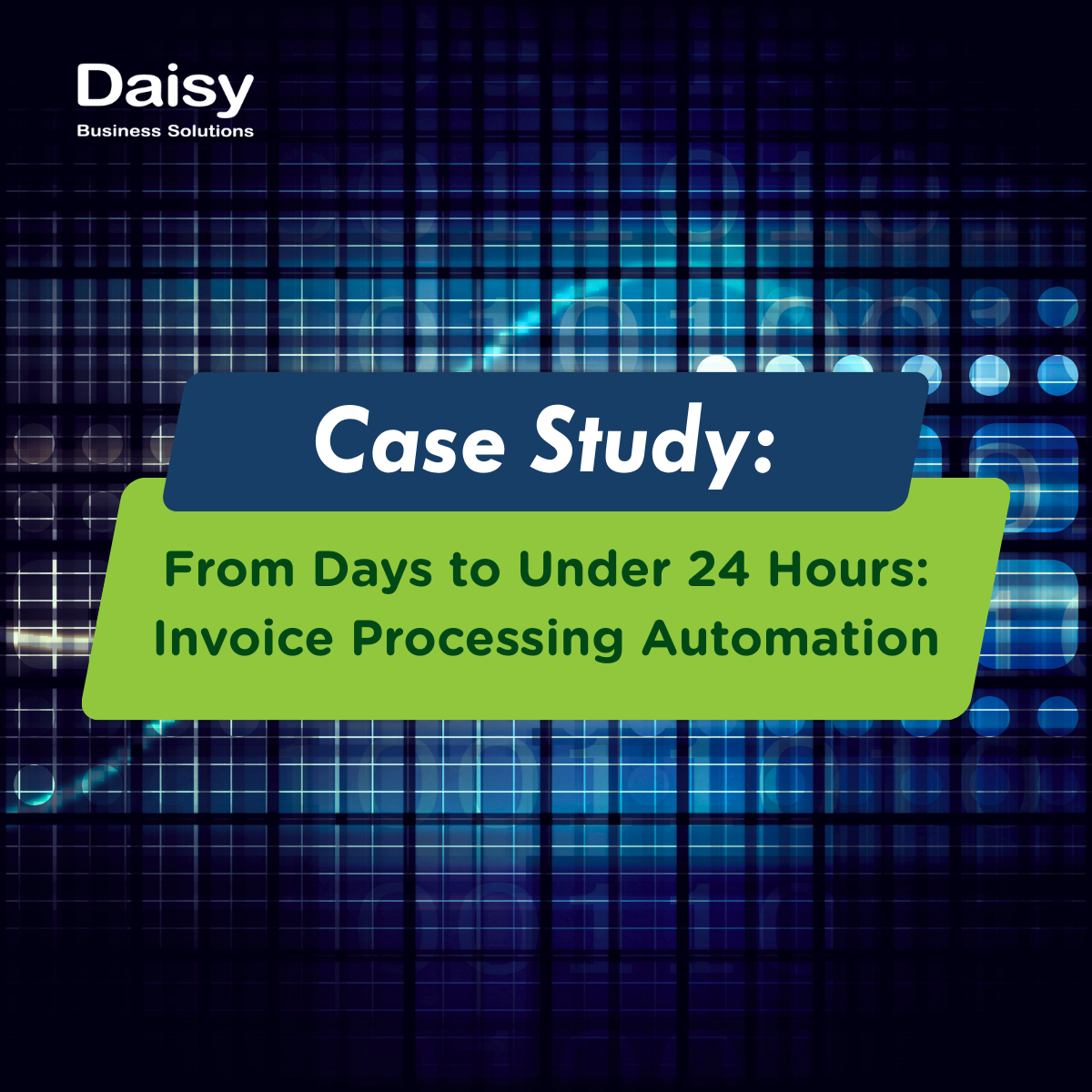CASE STUDY: Invoice Automation Transforms SA Retail Finance | Daisy Business Solutions
2025-08-22 17:26:25

TL;DR
A national food retail and quick-service chain in South Africa processed more than 15,000 invoices every month on paper.
Couriers and manual capture delayed posting by 5–7 days, and finance teams were stuck re-typing data.
Daisy Business Solutions implemented a Laserfiche-based approach that combined process automation, workflow automation, and secure electronic document management to cut manual capture by 80%, reduce posting to under 24 hours, and reach 99.7% data accuracy.
Workload dropped by about 50%, turnaround improved by about 70%, and a complete digital audit trail simplified compliance.
Reinforce resilience across branches with business connectivity and power continuity to keep scanning and posting online during outages.
Managed Network Services for SA Businesses 2025: End Downtime Now
Background
South Africa’s quick-service restaurant and food retail sector runs on thin margins and high velocity. Branches handle thousands of supplier invoices from warehouses, distributors, and service providers.
Historically, paper invoices were couriered to head office for capture in the ERP, which created 5–7 day delays. Load-shedding and courier disruptions amplified backlogs. Finance clerks re-typed line items rather than focusing on analysis and reconciliation. Missing paperwork and duplicates raised audit risk.
The leadership team knew the shift from paper to office automation had to preserve controls while improving speed. They needed scale, accuracy, integration with the accounting platform, and adherence to approval workflows.
Daisy Solutions proposed a Laserfiche architecture that unified document management systems with rule-driven approvals and straight-through posting.
Your Guide to Document Management and Automation
Bottlenecks in the Old Process
Manual capture and courier lag: Paper travelled to head office, then line items were keyed into the ERP. Payments slipped and late-fee risk rose.
Paper risk: Invoices could be misfiled or lost. Evidence retrieval for disputes took days.
Limited visibility: Managers lacked real-time liabilities until capture completed.
Load-shedding and geography: Rural branches faced power cuts and long transport times.
These are classic symptoms that business process automation alleviates by digitising inputs at source and routing exceptions centrally.
How to Measure the ROI of Process Automation
Solution Architecture (Laserfiche + Integrations)
1) Branch-Level Scanning
Branches now scan invoices on multifunction devices, sending files to a secure Laserfiche repository. This removes couriers and stops paperwork from going missing.
How Document Management Solutions Can Benefit Businesses in 2024
2) AI/OCR Data Extraction
Laserfiche capture applies OCR to read supplier names, dates, totals, VAT numbers, and line items. Low-confidence fields are flagged for validation. This is where OCR invoice automation tightens accuracy without slowing teams.
The Latest Trends in Document Management Technology
3) Exception Review
A small head-office team validates flagged fields in a clear screen. With 99.7% accuracy, most invoices pass straight through. Staff focus on anomalies and supplier queries instead of re-keying.
4) Automated Posting
Validated data posts into the ERP through integration connectors that respect approval hierarchies and value thresholds. No re-keying and no system hopping. This is practical automation software solutions aligned to finance controls.
Understanding Workflow Automation – A Beginner’s Guide
5) Security and Audit Trail
Every scan, edit, approval, and posting is timestamped and attributable. Role-based permissions govern access. This strengthens governance and shortens audits.
Load-Shedding Resilience and Uptime
Digitisation at the branch limits the impact of power cuts and courier issues. Pairing capture with managed IT services and managed network services maintains continuity.
Where links are critical, branches can add fibre, LTE, or SD-WAN for redundancy.
The Benefits of Fibre Connectivity for Businesses’ Speed, Reliability & Security
Empowering Remote Work: LTE & Wireless Connectivity Solutions
The Role of SD-WAN in the Era of Remote Working
Results
| Metric | Before Automation | After Automation | Improvement |
|---|---|---|---|
| Manual data entry | Full re-keying by clerks | Minimal exceptions | 80% reduction |
| Invoices processed | 15,000+ per month, paper | 15,000+ per month, digital | Same volume, faster |
| Processing time | 5–7 days to post | < 24 hours | ≈ 70% faster |
| Data accuracy | Variable, error-prone | 99.7% verified | Major uplift |
| Finance workload | Heavy admin load | ≈ 50% decrease | Staff redeployed |
| User base | Central finance only | 50+ users across branches | National scale |
Faster posting improves supplier relationships and can unlock early-payment discounts. Fewer manual touchpoints mean fewer errors and fewer duplicate payments. A full audit trail shortens month-end and external audits.
These gains compound when combined with managed firewall services and managed cloud services that protect and scale the platform.
Top 7 Reasons Why Your Business Needs a Strong Firewall
Cloud Managed Services - Everything You Need to Know (CAF and WAF)
What This Means for SA Retailers
Paper processes are fragile in dispersed, outage-prone environments. Scanning at receipt, validating exceptions centrally, and posting into the ERP reduces transport costs, accelerates payments, and keeps operations moving during interruptions. This is the practical side of office automation solutions that deliver accuracy and control.
How Office Automation Improves Accuracy In Businesses
How Daisy Helps
Daisy South Africa deploys Laserfiche with finance-grade controls and integrates with common ERPs. We map processes, configure capture and approvals, train teams, and monitor results.
For uptime, Daisy Telecoms provides voice connectivity and network resilience. For power, Daisy Energy Solutions supports continuity during outages.
This end-to-end approach to software solutions and infrastructure makes change manageable and measurable.
What Exactly Are Managed IT Services? How They Boost Productivity & Save Costs
The Future of Managed IT Services and What It Means for Your Business
Next Steps
Ready to see this on your invoices? Book a no-obligation consultation.
We will assess your current flow, volumes, and systems, then propose a proven path to results.
Book your expert consultation today.
Explore our document management system options and finance-ready online document management patterns.
FAQs
How does invoice automation work?
Branches scan invoices; OCR extracts key fields; exceptions are validated; approved data posts to the ERP with a complete audit trail. This is a core pattern in automated business solutions for finance.
Understanding the World of Office Automation (OA)
What ROI can finance teams expect?
In this case, manual capture dropped by 80%, posting time fell from 5–7 days to under 24 hours, and the finance workload decreased by about 50%. Savings come from labour time, fewer penalties, and fewer duplicates.
Will it work during load-shedding?
Yes. Scanning continues locally, with data queued for upload when connectivity returns. Uptime improves with business lte or uncapped business fibre as backup paths.
LTE for Business: Beyond Mobile Phones
Is it scalable to other document types?
Yes. The same platform captures delivery notes, purchase orders, and contracts, with tailored workflows per department. This is standard for document management services.
Invoice automation lets branches scan invoices, uses OCR to read the data, validates exceptions, and posts approved records to the ERP in under a day, cutting manual capture by about 80% and improving accuracy to about 99.7%.


